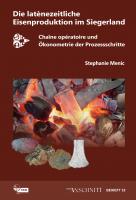Die latènezeitliche Eisenproduktion im Siegerland. Chaîne opératoire und Ökonometrie der Prozessschritte: Studien zu Montanlandschaft Siegerland 2
Keywords:
Iron Age, iron, prehistory, Latène Period, pre-Roman Iron Age, Germany, economic history, economic archaeology, craftsmanship, smelting, iron metallurgy, mining archaeologySynopsis
The Siegerland in the south of Westphalia is one of the most important mining areas of Central Europe. It is part of the right side of the Rhenish Massif and is crossed by the so called “Siegerland-Wied-district”, which is very rich in iron ore deposits. The iron ore of Siegerland was mined and melted into iron and steel from the Middle Ages to the 1960s. In the beginning of the 20th century the research of the two amateur archaeologists O. Krasa and P. Theis were the first who found slag heaps of the La Tène period in Siegerland. The publication focuses on questions of the archaeology of economics especially of iron production of the La Tène period in Siegerland. The study is based on the research of the DFG promoted cooperation project “The economy of iron production in Siegerland in the La Tène period”. To reconstruct the Chaîne opèratoire of iron production from raw material to product, not only the waste and remains of mining, smelting and forging had to be analysed with archeological and archeometallurgical methods. The analysis of pottery was also be included as well as the results of Anthracology, Palynology and Radiocarbon dating. The aim of this research was to examine the economic cycle of the La Tène period in Siegerland in as many aspects as possible. This includes also e. g. questions of trade routes, volume of production, trading partners or economic strategies.





